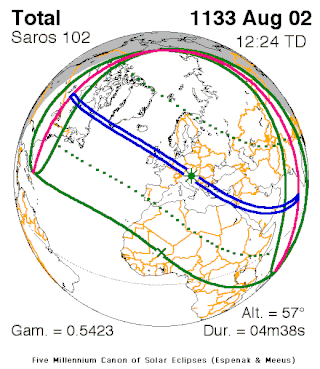Top Qs
Timeline
Chat
Perspective
Solar eclipse of August 2, 1133
Total eclipse From Wikipedia, the free encyclopedia
Remove ads
The solar eclipse of August 2, 1133, also known as King Henry's Eclipse, was a total solar eclipse visible in North America, northwestern, central and southeastern Europe and the Middle East. The eclipse is number 43 in the Solar Saros 102 series. The eclipse was widely regarded as a bad omen in England and Germany.
Remove ads
Eclipse path and details
The instant of the greatest eclipse took place at 12:24:22 terrestrial dynamical time (TD), which corresponds to 12:08:36 universal time (UT1). This was exactly one day after the Moon reached perigee. The Sun was during the eclipse in the constellation Leo. The synodic month in which the eclipse took place had a Brown Lunation Number of -9763.
The solar eclipse of 2 August 1133 was a comparatively long total eclipse with a duration at the greatest eclipse of 4 minutes and 38 seconds. Its eclipse magnitude was 1.0652.
Records of this eclipse have helped determine the historical rate of the deceleration of Earth's rotation.[1]
Remove ads
Public reception and coverage in literature
Like many other eclipses, the solar eclipse of 2 August 1133 was considered a bad omen. This perception was underscored by the fact that it coincided with the final departure of King Henry I of England to Normandy, shortly before the country was thrown into chaos and civil war.[2][3][4] It was described by William of Malmesbury.[5] According to him, the “hideous darkness agitated the hearts of men.”[6] One scribe described the event as "miserabilis, horribilis, nigra, mirabilis": "wretched, horrifying, black, remarkable."[7]
In Germany, the eclipse was regarded to predict the sacking of the city of Augsburg and the massacre of its inhabitants by Duke Frederick.[8]
The eclipse is mentioned in the Peterborough Chronicle, the Annales Halesbrunnenses,[9] two of Cosmas's continuators (the canon of Vyšehrad and the monk of Sázava),[10] the Codex diplomaticus Falkensteinensis[11] and the Chronicon Scotorum.[12]
Remove ads
References
External links
Wikiwand - on
Seamless Wikipedia browsing. On steroids.
Remove ads

